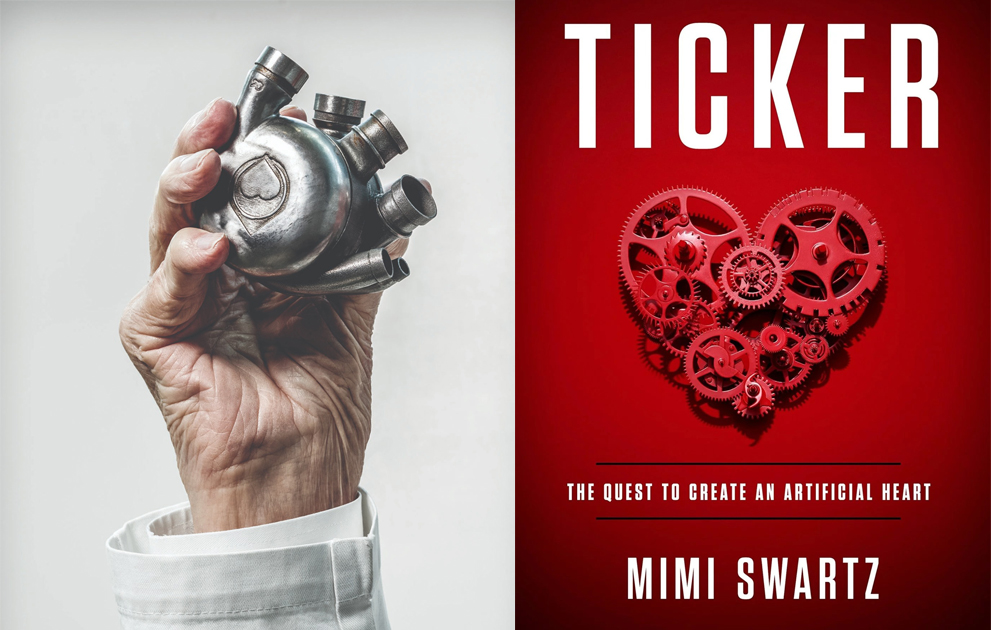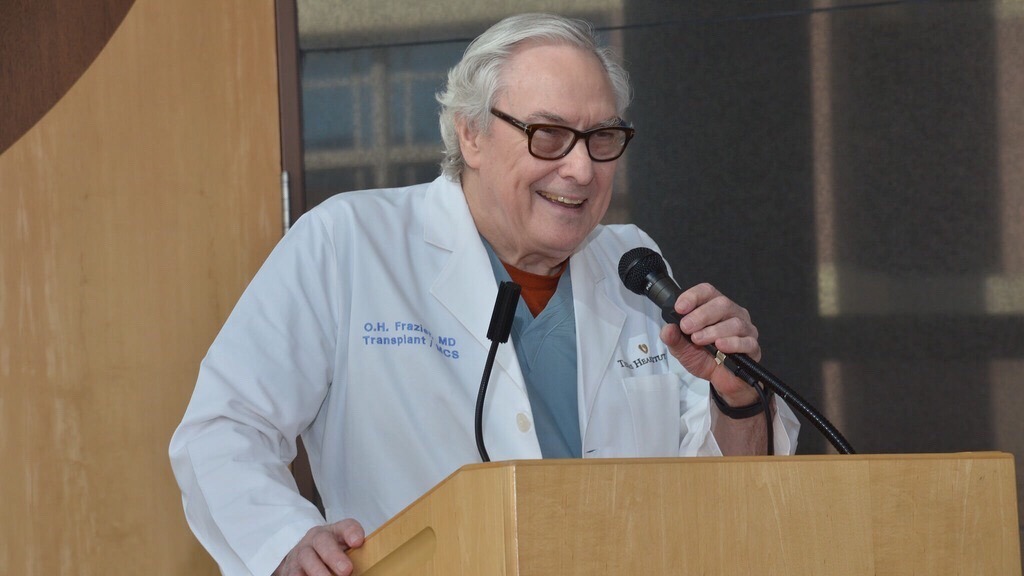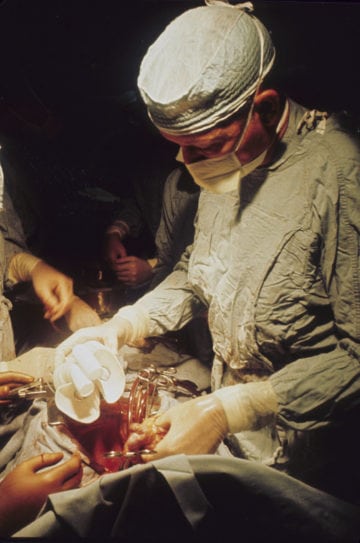
Tinkering with the Human Heart in ‘Ticker’
Set in Houston, Mimi Swartz’s new book delivers an engrossing human drama populated with off-kilter geniuses.
Above: Left: O.H. “Bud” Frazier holding the Bivacor artificial heart in 2016. Right: Ticker: The Quest to Create an Artificial Heart by Mimi Swartz; Crown; $27; 304 pages
Early in Mimi Swartz’s fascinating Ticker: The Quest to Create an Artificial Heart, a surgeon with no good options left cuts out a sheep’s heart and transplants it into a patient lying practically dead on the operating table. It’s a story that captures the book’s slightly mad-scientist spirit and sets the tone for what’s to come: a chronicle of the pioneering doctors and inventors, desperate to save fragile lives, who have sought for decades to replace failing hearts with machines.
This wide-ranging story is in good hands with Swartz, a longtime Texas Monthly executive editor and formidable journalist who twice has won a National Magazine Award. In bringing to life more than 70 years of medical history, she often achieves a novelist’s level of telling detail, the kind that can only result from determined, painstaking reporting. One surgeon’s parents were not just well-educated; his mother “had been in Sylvia Plath’s class at Smith.” A patient makes his wife “a recipe box out of soft yellow pine.” Swartz stacks up the specifics to bring her account to vivid life.
She also provides readers focus, centering the narrative on one place and person. Most of the action is in Houston, where post-World War II wealth funded the Texas Medical Center and later its trailblazing Texas Heart Institute. She casts as protagonist the legendary surgeon O.H. “Bud” Frazier, a drawling, driven native of Stephenville, Texas, who has performed more than 1,300 heart transplants and long ran the institute’s research lab.

Frazier is the natural choice; for decades, he was the maverick at the forefront of experimental heart surgery research. Swartz depicts him as a risk-taker with little patience for bureaucracy, an attitude that may have come to haunt him now, as he approaches 80. In May, ProPublica and the Houston Chronicle published a scathing investigation of Frazier’s practices that alleges ethical lapses and financial malfeasance; the surgeon is now suing both publications. An advance copy of Ticker provided for this review does not address the controversy.
The other characters are also a colorful bunch, especially Frazier’s fellow cardiac surgeons, “who have a lot more in common with the people who crossed Everest’s Khumbu Icefall or took the first steps on the moon than your kindhearted family doctor,” Swartz writes. Chief among them are Frazier’s brilliant professional forebears, the imperious martinet Michael DeBakey and his opposite in appearance and temperament, Denton Cooley, forever linked as colleagues turned rivals. (The 1960s TV series Ben Casey is said to have loosely dramatized the famous pair’s yin-and-yang relationship.)
Where there is technology there are tinkerers, and along the way Swartz introduces a few of the off-kilter genius variety. They include Frazier’s late-career right-hand man Billy Cohn, whom we first encounter as he devises his Houston neighborhood’s coolest automated Halloween decorations. Onto the scene later comes young Daniel Timms, an Australian digital native who began experimenting with artificial heart concepts as a boy alongside his father, a plumber who had suffered a heart attack at 55.

DeBakey and Cooley were among the first generation of cardiac surgeons empowered by the heart-lung bypass machine, the late-1950s innovation that allowed open-heart operations for the first time. The next leap may have been inevitable: In 1967, a South African surgeon named Christiaan Barnard completed the first human-to-human heart transplant. At this point Swartz’s account breaks open and gains energy, as visionaries such as Cooley and Frazier embrace the potential of mechanical devices to temporarily keep sick hearts functioning until surgeons could replace them. Creating a permanent artificial replacement was a goal, but seemed far less achievable than stopgap technologies such as the left ventricular assist device that DeBakey had recently begun implanting.
What happens next is, of course, a technology story. Prototypes of full and partial artificial hearts come and go, tested on calves in the Texas Heart Institute basement lab/menagerie, tried out in patients who would have died anyway, and subject to the forces of media scrutiny and venture capitalism. The tech roughly tracks a moon shot to space shuttle to Martian rover trajectory, with an initial boom, a workaday middle period and a contemporary, digitally designed cutting edge. (Swartz repeatedly touches on comparing artificial heart development with the space program, but never fully expounds the idea.)
There was even an analog to the Challenger disaster: the Barney Clark case. Clark’s name will ring a bell for anyone who read a headline in 1982, the year he survived for 112 miserable days with a crude artificial heart called the Jarvik-7 in his chest. Complication piled on complication until Clark was “suffering from, among other things, renal failure, pneumonia, gout, painfully swollen testicles, and an ulcer” in addition to brain damage, and he asked to be allowed to die. The PR resulting from his agony is thought to have set back research for years.
Alongside the technology tale, Ticker also tells a story about health care economics. Promising devices end up in landfills when they prove too expensive for the tastes of the money men. When other, previously reliable sources of funding dry up, Cohn resorts to asking for investment from “Mattress Mack,” famous in Houston for his wacky discount furniture commercials.
In bringing to life more than 70 years of medical history, Swartz often achieves a novelist’s level of telling detail, the kind that can only result from determined, painstaking reporting.
Most importantly, though, the history of artificial heart replacements is a human story that’s most affecting when Swartz describes the patients, their illnesses, their recoveries and their crashes — much more relatable stuff than the vagaries of federal research funding. It was in those moments, imagining standing at a pallid patient’s bedside, when I found my hand on the center of my chest. The doctors and bioengineers, their interpersonal dramas and their gee-whiz gizmos, are interesting. But they may have seemed more meaningful if there were more focus on patients’ plights.
The book ends on a hopeful if unresolved note, with Timms in recent years at the Texas Heart Institute developing and promoting what could be the long-sought real thing: an artificial heart that can be implanted and forgotten about, which will even adjust blood flow to activity level. Unsurprisingly, the final hurdles are financial, as the price of ever-more-demanding FDA trials and other research has reached many millions of dollars.
Still, Swartz leaves the impression that we are not far from ending the journey begun on April 4, 1969. On that day, a print shop price estimator from Skokie, Illinois, named Haskell Karp became the first recipient of an artificial heart, which kept him alive for 65 hours. Ticker makes achieving a truly viable version within a century of that date seem not just possible, but inevitable.


